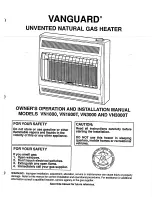
18
Servicing should only be performed by a Quali
fi
ed Service Technician
Setpoint at Min Volts
When programmed for BMS control through the 0 - 10V BMS input or through ModBus and the BMS Type is
programmed as SETPOINT, the set point represented by the Volts at Minimum parameter is set by the Set
Point at Maximum Volts parameter. The minimum value is 32°F (0°C) and the maximum is the Set Point at
Maximum Volts setting. The default value is 70°F (21°C).
Setpoint at Max Volts
When programmed for BMS control through the 0 - 10V BMS input or through ModBus and the BMS Type is
programmed as SETPOINT, the set point represented by the Volts at Maximum parameter is set by the Set
Point at Maximum Volts parameter. The minimum value is the Set Point at Minimum Volts setting and the
maximum is 190°F (88°C). The default value is 180°F (82°C).
On Volts
When programmed for BMS control through the 0 - 10V BMS input or through ModBus and the BMS
Thermostat Input is set to INACTIVE, the On Volts parameter determines the 0 - 10V BMS input voltage at
which the water heater is enabled. The minimum value is 0.5V and the maximum is 10.0V. The default value
is 2.0V.
Off Differential Volts
When programmed for BMS control through the 0 - 10V BMS input or through ModBus and the BMS
Thermostat Input is set to INACTIVE, the Off Differential Volts parameter determines how far below the On
Volts setting the 0 - 10V BMS input voltage must be in order to disable the water heater. The minimum value
is 0.2V and the maximum is the On Volts setting. The default value is 1.0V.
LEAD/LAG
Address
The water heater designated as the Leader needs to be programmed with address 0. All the Member water
heaters require addresses from 1 to 7, and the addresses must be different for each Member. The addresses
can be in any order, regardless of the order in which the units are wired together. This parameter is adjustable
by the installer by accessing the Lead/Lag Address parameter. The tank sensor must be connected to the
Leader water heater. The default address is 1.
Lead/Lag/ Ef
fi
ciency Enhancement Types
There are two (2) options for the way a Lead/Lag divides the load between its heaters. The
fi
rst is Lead/Lag,
designated as L/L in the menu. This method is used when it is desired to have the least amount of total
fl
ow
through the water heaters. This method will modulate the last two (2) water heaters. This provides for smooth
transitions when a water heater turns on or off. When the last water heater reaches 100% and the calculated
load is still increasing, it will start the next water heater at 20% and reduce the previous water heater to 80%,
thus eliminating the sudden jump in total output of the Lead/Lag. When the calculated load is decreasing
and the last water heater gets down to 20%
fi
re, it will hold it there and start lowering the
fi
ring rate on the
next-to-last water heater. When the next-to-last water heater reaches 20%, it will turn the last water heater
off and raise the rate of the next-to-last water heater to 40%, thus eliminating the sudden drop in total output
of the Lead/Lag.
The other Lead/Lag divider method is Ef
fi
ciency Enhancement, designated as Ef
fi
ciency in the menu. This
method is used, as the name implies, when it is desired to have the most ef
fi
cient system. When the
fi
rst
water heater reaches a certain rate (default = 90%), it lowers its rate to 45% and turns on the next water
heater at 45%. The two (2) water heaters then modulate at the same rate.
As the calculated load increases further and both water heaters ramp up to 90%, it lowers the rate of the
fi
rst
two (2) water heaters to 60% and brings the next water heater on at 60%. The three (3) water heaters then
modulate together. As the calculated load decreases, the water heaters will reach a lower threshold (default =
30%), at which time the last water heater (the third in our example) will turn off and the Lead/Lag will increase
the rates of the remaining water heaters to provide the equivalent total output as before ((3 x 30%) / 2 = 45%
in our example).
Ef
fi
ciency Enhancement is automatically selected when heaters of different sizes are programmed into the
Leader water heater (see DHW Size on Page 19).
















































